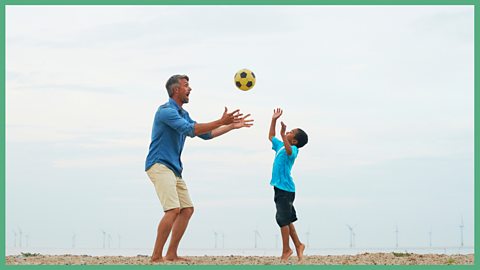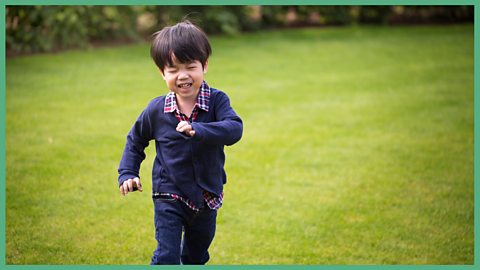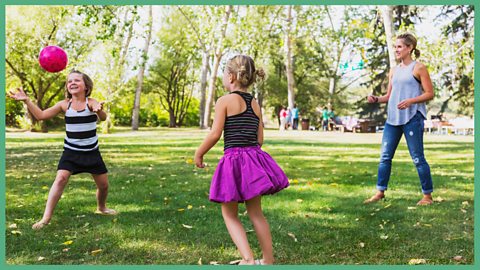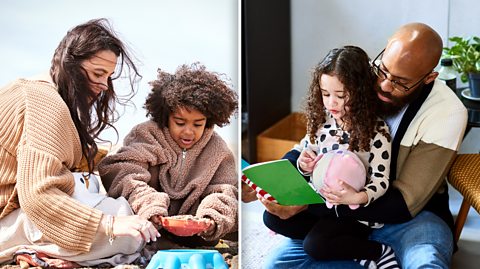How do you get the kids outdoors? Get creative with these five fun games that will help keep your child's mind and body on the go, whether you're in the garden, at the local park, on the beach, or somewhere else on a family adventure
These activities, created in partnership with , are suitable for the whole family and can easily be adapted for disabled children and individuals with special educational needs - so get outdoors and play!

Adapting activities using STEP
STEP is a simple tool, created by the , to help you make an activity more inclusive. With these games, think about
Space - Where is the game happening? Do you need to change the size of the playing area, or the playing surface?
Task - What activity is happening? Can you adapt it to make it easier or harder?
Equipment - What is being used for the game? You'll need a ball for a few of the games below - think about the size, shape, colour, texture and weight. Does it need to be a ball? How about a balloon or soft toy?
People - Who is involved in the activity? Give people specific roles and change round teams to balance games.

Solar Simon says

All you need for this one is a ball, of any size and shape, for each player.
The leader (for the first round, this can be you, the parent) sets codewords for each player. We've made our codewords space themed to match our night-time summer activites, but they can be anything you, or your child, want them to be. Here are our examples
ÔÇÿGo meteor!ÔÇÖ - throw the ball in the air and catch it.
ÔÇÿGo moon!ÔÇÖ - bounce the ball on the ground.
ÔÇÿGo asteroids!ÔÇÖ - swap balls with another player (or the leader if itÔÇÖs just two).
Like with Simons Says, the codeword only works with 'Go' in front of it - you can try and catch the players out by leaving it off and seeing who still does the action! A player is out when they perform the wrong action for the codeword, or react to a codeword without 'Go'.
If a player is out, they can keep active until the next game by seeing how many times they can throw their ball in the air and catch it without it touching the ground.
Talk to your child about the actions for each codeword, and feel free change them into something they feel more comfortable doing, perhaps they could turn on the spot with the ball in their hands, or a slightly trickier action if they want to set themselves a challenge, like using their weaker hand!
Remember to swap and let them have their go as leader - it's just as fun!

Slalom at the beach

Here's a fun game for when you're by the seaside
To start, each player builds a simple sandcastle - if you have multiple players, try to make these in a line.
Next, help your child find shells, stones, and seaweed on the beach - about 10 items each will do - and place these one-by-one in a line leading to their sandcastle, creating a slalom course.
If you have multiple players, try to make these lines a similar distance, but you can adjust the courses depending on what your child will be most comfortable doing. You could create a longer, or shorter course, and consider how far apart the slalom objects are from one another - having them close together will test the player's agility, whereas having them spread out will be a less challenging option!
Think about the surface you play this game on too. Dry sand will be more difficult to manoeuvre on than wet.
Now, each player must start at their sandcastle, race to the end of the course, dodging around the beach items, and back again. The first person to smash their sandcastle is the winner!

Animal races

This is a fun outdoor game for the wildlife lovers in the family.
Use four or more items (jumpers, stones, anything you have to hand) as cones to create a simple race course.
The object of this game is for each player to move around the course, while a leader (this could be you for the first round) shouts out animals that correspond to a certain movement style. For example
'Rabbit!' - hop around the course
'Badger!' - crawl around the course
'Deer!' - skip or move as fast as you can
'Crab!' - move sideways
As a parent, you can adapt or change these actions to your child's ability and comfort, but let them choose which animals best suit each action. Perhaps they prefer to put hands on their head as ears for 'Rabbit!, or snip their hands like claws for 'Crab!'.
If they're finding the movements too challenging, they could even make the sound of the animal instead as they go around the course.
Remember to set how many laps it takes to complete the course, then ready, steady, go!

Tree bounce

Planning a family forest expedition? Time for a game!
Take a ball with you, or help your child forage for pine cones or conkers (there will be a few around this time of year) on the way. Once you've stopped for a break, find a suitable tree and set up a square target in front of it using twigs and sticks you find on the forest floor.
Now, the aim for each player is to try and bounce the ball, pine cone, or conker off of the tree trunk and back into the target square. One point if it lands in there and bounces out, five if it stays in the square!
You can easily adjust this game for different abilities by changing the distance between the tree and the square, or by making the square bigger or smaller.
If your child has a visual impairment, you could give them guidance on where the ball lands in the square each time they throw.

How fast can you pass?

Minimum four players for this game.
Time to head out somewhere with plenty of space - the local park, or the beach is perfect!
For this game you need a ball. Stand in a circle. One player starts with the ball and throws it to the person on their left, before racing around the circle and coming back to their spot.
Each player does this one-by-one, with the aim of the game being to get back to your spot before the ball goes around the circle, then continuing until someone drops the ball.
To adjust the game for different abilities, you could try different actions, instead of racing around the circle. Perhaps the players have to turn on the spot, or move to the middle of the circle and back.
Think about the type of ball you use as well - a tennis ball might be trickier to catch than a beach ball. You could even use a balloon and fill it with some rice so it makes a sound in the air!

is the national charity and leading voice for disabled people in sport and activity in England. Activity Alliance work alongside the Youth Sport Trust and fellow Home Nation Disability Sports Organisations to support parents and teachers provide fun, inclusive sport and physical activity opportunities for all disabled children and young people.
These activities have been adapted from the Inclusive PE Activity Cards produced by Activity Alliance, Disability Sport Northern Ireland, Disability Sport Wales, Scottish Disability Sport and the Youth Sport Trust.

For more inclusive games check out Let's Do This from ┤¾¤¾┤½├¢ Bitesize. A series of outdoor activities including Bat the Ball and Balloon Tennis!

More from ┤¾¤¾┤½├¢ Bitesize Parents' ToolkitÔǪ
Parents' Toolkit
Fun activities, real-life stories, wellbeing support and loads of helpful advice - we're here for you and your child.

24 ideas to entertain the kids over the summer
Take a quick quiz to find a summer activity for you and your child! The summer activity idea generator has over 20 indoor and outdoor activities to try out so you and your kid will never get bored!

How to find the constellations
From the little bear, to the swan, there are plenty of asterisms to teach your child this summer.

How to spot the International Space Station
The ISS has been whizzing around Earth for over 20 years - here's how you can spot it.

How to spot bats in the UK
Where to find them, how to spot them and some bat facts to wow the kids!

How to catch a meteor shower
You might think spotting a shooting star is pure luck, but there is a way to predict when a meteor shower might hit.
